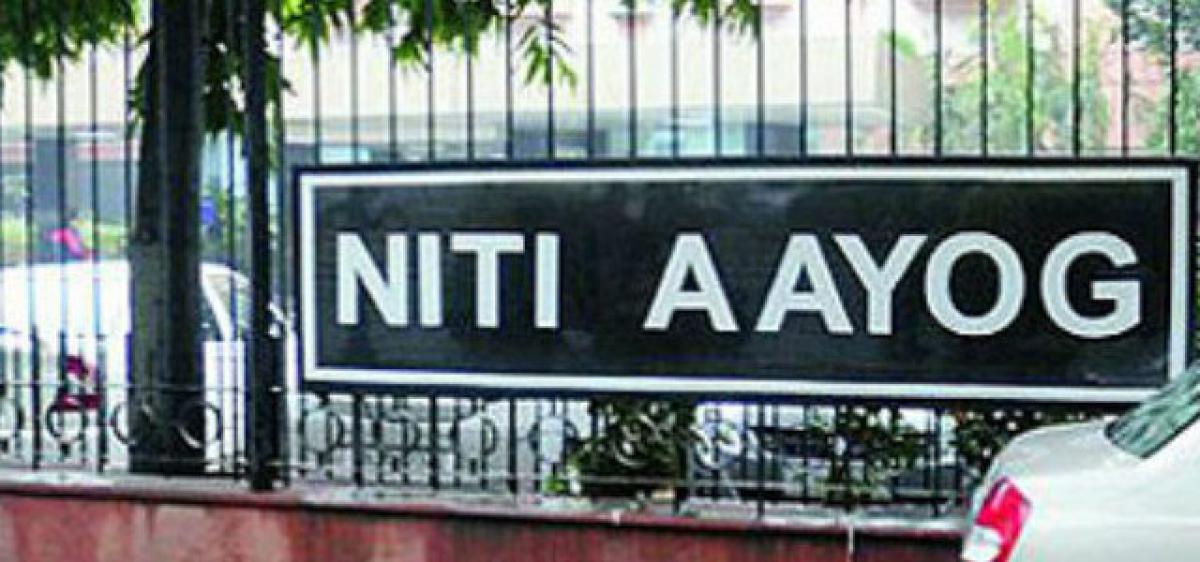Live
- World Liver Day 2024: Theme, History, and Significance
- Google Pixel 9 Rumoured AI Features: Magic Composer, Autofill Smart Reply, and More
- Malladi Vishnu complains to EC on Naidu, Ayyanna & Pawan
- MyVoice: Views of our readers 19th April 2024
- Peddireddi touched my feet for DCC post, recalls Kiran
- All politicos must commit to free press
- iPhone 17 Plus Rumors: Potential Smaller Screen Size for the 2025 iPhone
- Risk of Middle East escalation
- 50 families quit YSRCP, join TDP
- Nara Bhuvaneshwari to File Nomination Papers on Behalf of TDP Chief Chandrababu in Kuppam
Just In

India’s top think tank Niti Aayog with an aim of transforming India in fifteen years, has envisioned an ambitious agenda for the country to be achieved by 2032.
India’s top think tank Niti Aayog with an aim of transforming India in fifteen years, has envisioned an ambitious agenda for the country to be achieved by 2032.
It aims to transform India into a “prosperous, highly educated, healthy, secure, corruption-free, energy abundant, environmentally clean and globally influential nation.” The question, however, is whether it is possible?
The third meeting of the Governing Council of NITI Aayog was held in the National Capital recently. The five year plan will now be replaced by a three year action plan which will be part of a 7 year strategy that would in turn help realize a 15 year long term vision.
The targets set by NITI Aayog for the next 15 years includes-Three-fold rise in GDP-At present India’s GDP is around Rs 137 lakh crore (at 2015-16 prices). The think tank has predicted that GDP would witness an average growth of 8% per annum and rise up to Rs 468 crore by 2031-32.
Rs 2 lakh increase in per capita GDP-India’s present per capita GDP at 2015-16 prices is Rs 1,06, 589. The Niti Aayog has predicted it to rise up to Rs 3,13,66 by 2031-32.
Urban population to rise by 22 crore –According to 2011 Census, the Urban population of India was 37.7 crore. It is expected to reach 60 crore by 2031-32. Three-fold increase in Central, state expenditure-At present, the Central and expenditure in India is Rs 38 lakh crore.
It is expected to reach Rs 130 lakh crore by 2031-32, according to Niti Aayog. Facilities for people-The vision envisages that housing with toilets, electricity and digital connectivity for all and access to two wheelers or cars, air conditioning and other white goods for nearly all.
Universal access to healthcare to all literate, along with much modern network of roads, railways, waterways and air connectivity. A clean India, with clear air and water, clean cities and villages.
The job of NITI Aayog should have been to identify the immediate challenges that the country faces to realize a vision set rather than writing a manifesto for coming years such as global environment, consistent poverty in the country, regional inequalities among many others.
NITI Aayog should mobilize the country to address real challenges. An 8% growth rate is achievable because in last 25 years, the average growth rate was 6.7%.
Economy is consistently increasing. Few things need to be brought into focus- Inclusiveness by providing health facilities, education for all, expenditure in rural infrastructure, skill development etc.
Resilience by strengthening public institutions, banking system, regulatory environment, management of natural resources.
Though these things have to be focused upon but it is even more important to understand that why there is a lag in education, healthcare etc even in a high growing economy.
The government promises clean and quality air in the agenda but this goal might run into contradiction from the aspiration to ensure a private car or two-wheeler for every citizen.
This kind of a vision is being given when the world is moving towards maximizing environment friendly public transport options and eco-friendly methods like huge promised investment on solar power.
However, the government intend to double the farmers income by 2022, to achieve it, Agricultural development needs to be planned on five key issues such as Enhancing productivity, Land leasing reforms, Remunerative prices, Risk management, Second Green Revolution in eastern India
According to Niti Aayog estimates, the combined expenditure of Centre and State would rise by Rs 92 lakh crore to reach Rs 130 lakh crore by 2031-32.
By 2031-32, India’s urban population would rise by 22 crore and reach around 60 crores. Niti Aayog also projects that per capita income in the country would rise by Rs 2 lakh up to Rs 3,14,667.
Economy is expected to grow three-fold in 15 years. If economy grows at an 8 percent average rate for the next 15 years, our GDP will be Rs 469 lakh crore by 2030 (around USD 7.25 trillion).
NITI Aayog also came up with indices for measuring states’ performance in health, education and water management to help states gauge the results of social programmes and compete with each other and share best practices and innovations.
It also suggested clubbing various social programmes and centrally-sponsored schemes under 28 umbrella projects.
The panel suggested changes in Swachh Bharat Abhiyan, skill development, poverty measurement, Atal Innovation Mission.
Yearly targets and their monitoring can help the Government to better monitor and streamline its performance for the goals set which is perfectly placed. Unwavering political will and public support will help in realizing these goals.

© 2024 Hyderabad Media House Limited/The Hans India. All rights reserved. Powered by hocalwire.com







